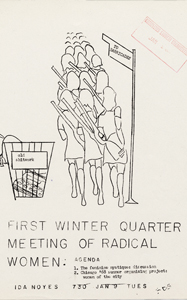Equal opportunities?
By Ruth E. Kott, AMí07
Image courtesy the Special Collections Research Center

In the 1960s, as revolutionary student groups emerged across the country, radical University of Chicago women broke off from the school’s core movement. Believing that the male-dominated New Left subordinated University women, they organized separately.
The 1960s and ’70s marked a shift in how women viewed themselves, says history PhD student Katherine Turk, AM’07, who helped organize a Special Collections exhibit on Chicago’s female students. Through the early 20th century U of C women—by rule—lived and socialized apart from men, and many scholars faced discrimination; later campus feminists fought for equality in education, employment, and rights.
Coed early on, the University in its first years tried to shape “the perfect woman,” Turk says. Administrators like Dean of Women Marion Talbot supervised every activity from study to exercise. The Department of Household Administration, shut in the 1950s, offered courses on home ownership and child development. Single-sex organizations fostered strong female networks, though at times administrators feared the University’s “feminization.”
For the exhibit “On Equal Terms”: Educating Women at the University of Chicago—up through July 14—Turk and Monica Mercado, AM’06, used archival documents from the Center for Gender Studies’ History of Women Project, such as this women’s-lib meeting poster from 1968. The goal: to tell the story of women’s integration into the curriculum and the community. Studying women’s past at Chicago, the curators emphasize, offers a new perspective on the history of the University and the history of feminism.
